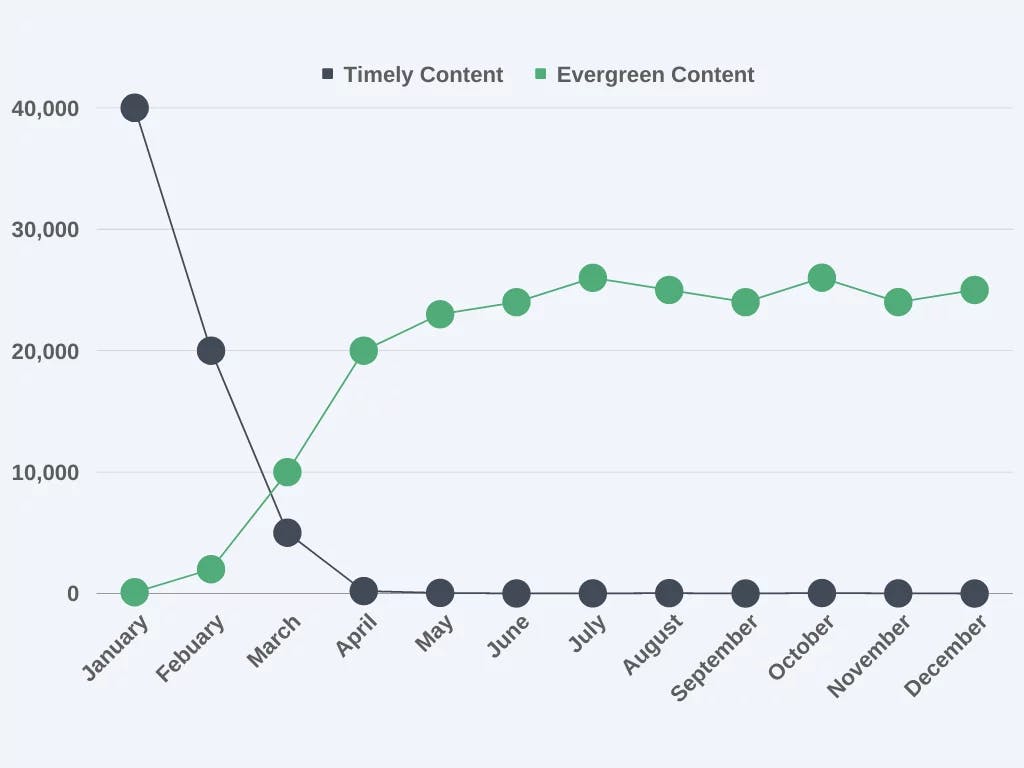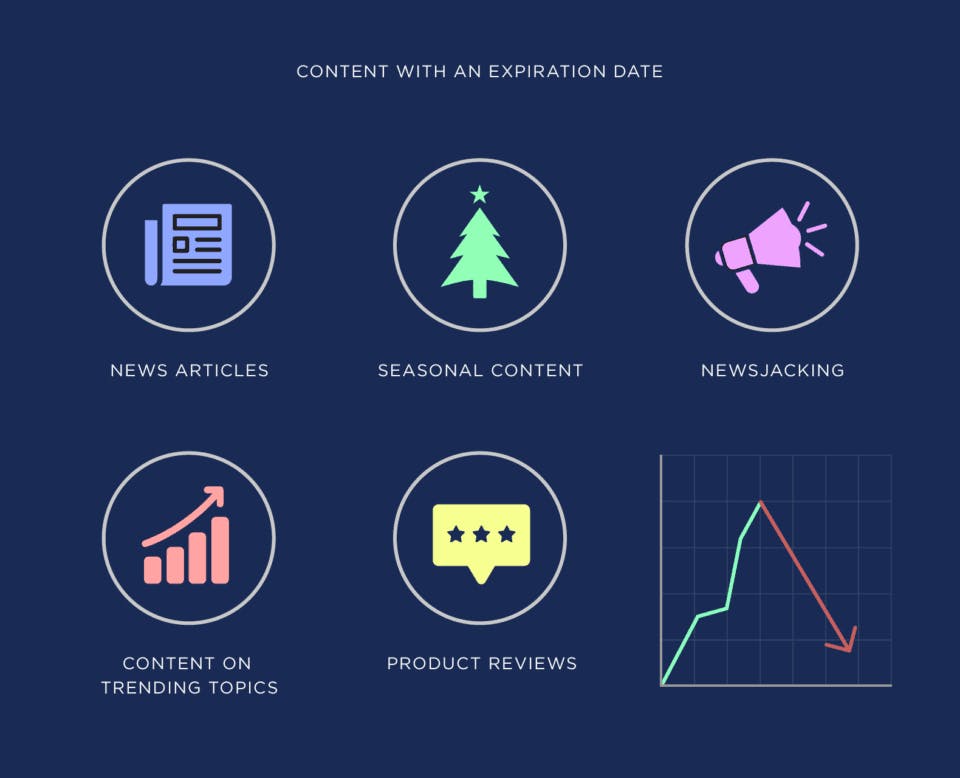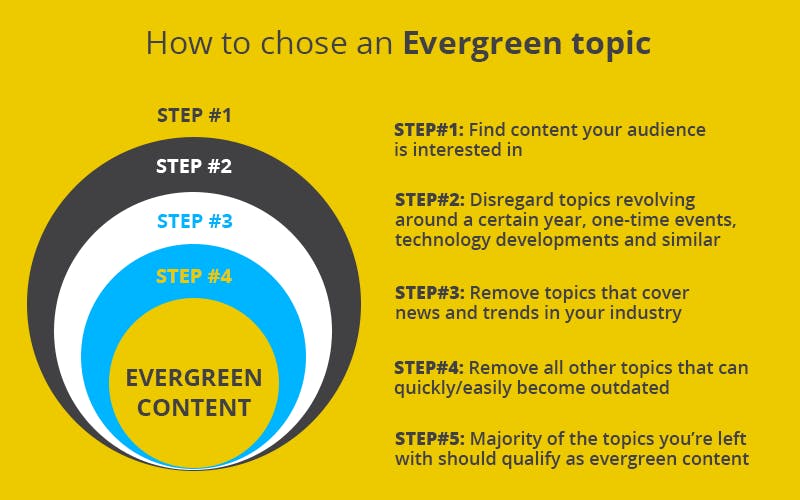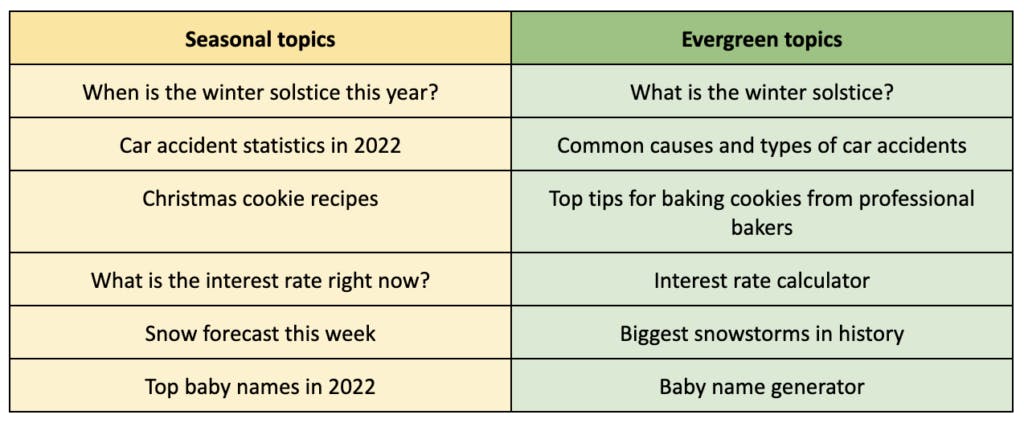Evergreen Content: Definition, Strategy and Examples
Dec 26th, 2023

Contents
What is evergreen content?
Evergreen content strategy
Examples of evergreen content
Updating evergreen content
Evergreen content is timeless. This type of content analyzes a topic or problem, offering information that captures the audience’s interest and adds value to your website. Even though producing evergreen content requires a considerable amount of time and money, it is worth the investment. If you want to improve your search rankings, generate long-term traffic, and help your audience solve their problems, evergreen content is exactly what you need.
While evergreen content is the basis of your content marketing strategy, balancing it with trend-driven and timely materials is essential. This combination allows you to maintain relevance and simultaneously address evolving audience needs. This article will explain the concept of evergreen content, how to find and choose topics for evergreen publications, and how to create such content pieces. We will also provide examples of evergreen content that were published some years ago and still rank among the top positions in search results.
What is evergreen content?
Evergreen content is a type of content that remains valuable to the audience over a long period. The term is derived from the evergreen tree, which retains its leaves throughout the year, symbolizing the usefulness of this type of content. Evergreen content does not cater to a niche audience, lacks a specific expiration date, and maintains its accuracy without regular updates.
Conversely, seasonal or time-sensitive content focuses on topics associated with a specific time of the year or trendy events that are prevalent in the news or social media. Trend-driven content is relevant only for a particular period and loses its value or accuracy as time passes. Examples of such publications include news articles, statistical or number-oriented materials, event announcements, seasonal promotions, or trending topics that quickly become outdated.

The main characteristics of evergreen content include timelessness, longevity, value, and optimization for search engines. The content addresses topics or provides information unrelated to specific events, trends, or dates. Moreover, evergreen content continues attracting traffic or engagement over an extended period, often for months or years. These publications may answer common questions, provide solutions to problems, offer in-depth guides, or share educational information that people will find useful over time.

Now, we will take a closer look at the types of evergreen content. This will help you generate content ideas that maintain relevance and consistently attract traffic and engagement to your website.
Types of evergreen content
There are various types of evergreen content, and here are some examples:
- How-to guides and tutorials. Step-by-step guides on topics relevant to your industry or niche. These materials can be aimed at beginners in your industry, helping them understand the basics and get started.
- Explainers. These publications or explainer videos describe how complex processes, systems, or technologies work in a simple and understandable way.
- Listicles. Lists of tools, resources, or examples related to your niche. A listicle typically consists of a brief list containing 10 to 20 items focused on a particular topic.
- Frequently asked questions. This is a list of commonly asked questions and detailed answers. It typically offers solutions to common problems or challenges faced by your audience.
- Product reviews. In-depth and unbiased product reviews that are relevant to your industry, enhanced with video demonstrations.
- Comparison and versus articles. These publications compare different products, services, or approaches to help readers make informed decisions.
- Historical and background content. Information about the history, background, or evolution of a particular topic, concept, or technology.
- Case studies and best practices. This type of content analyzes real-world examples of how a product has helped a person or a company achieve a specific goal or solve a problem.
- Expert interviews. Interviews with thought leaders or industry experts. You can also share their insights and advice in video format.
- Inspirational stories. Stories of individuals or companies who have achieved success, overcame challenges, or significantly impacted your industry.
- Resource lists. Lists of valuable resources, such as tools, websites, books, or courses.
Creating content in these formats doesn't automatically turn your materials into evergreen pieces, but they are generally better suited for evergreen writing than other content types. For example, instructional videos that offer practical information, such as demonstrating how to change a tire, tend to maintain relevance longer than less practical videos.
Evergreen content strategy
Evergreen content strategy is a highly effective method for increasing traffic to your website or blog. In the following section, we'll outline the steps to create evergreen content that provides lasting value, establishes your brand as an authoritative source in your niche, and engages your visitors, improving user retention rates.
Step 1. Define your audience and goals
Before creating evergreen content, it's crucial to have a clear understanding of your target audience and their needs. Define your customers’ demographics, interests, and pain points. Then, set specific goals for your evergreen content, such as driving organic traffic, building brand authority, or generating leads. These insights will guide your content creation process. Once you have identified the audience’s interests and preferences, you can establish a direction for your content and derive long-term value from it.
To learn more about your target audience’s characteristics, create a customer persona that represents your ideal consumer. Utilize this persona to influence every element of your content creation, including design, layout, writing style, and tone. In addition, you can ask questions on Quora and Reddit or leverage your social media platforms to ask people about specific issues they face in their daily lives and use them as a topic list for your content efforts.
Step 2. Conduct keyword research
Perform keyword research to determine search terms pertinent to your niche and have a steady search volume. Employ resources like Google Keyword Planner or Ahrefs to identify keywords with low competition but high search intent. Take into account long-tail keywords that consist of three to four words. Compile a list of relevant keywords to form the basis of your evergreen content.
Then, use Google Trends to identify topics people consistently search for throughout the year. Check your keywords with this tool by selecting the Worldwide option and choosing Past 12 months or Past 5 years. This ensures that your selected keywords are not experiencing a decline in interest, a critical factor for evergreen content. In addition, focus on keywords with consistent or upward-trending search volume, as these are more likely to provide enduring value to your audience.
Step 3. Choose timeless topics
Focus on topics that are not time-sensitive and have enduring relevance. Evergreen content should stand the test of time, so opt for themes that won't quickly become outdated. Topics like "Beginner's Guide to Investing" or "How to Start a Vegetable Garden" are timeless and can be valuable for years.

Conduct research to identify evergreen niches that consistently capture people's attention within your industry. Explore the core principles of your field that remain relevant regardless of technological advancements or shifts in industry trends. Determine the common challenges or pain points your audience faces and create content that provides lasting solutions.
It is possible to turn your existing content into an evergreen version even if your initial intention wasn't to create this type of material. For example, you can write a new introduction or remove any seasonal or time-sensitive references. Keep in mind that it is better to avoid trendy images in evergreen articles. Instead, focus on timeless visuals as they indicate that the content remains relevant today.
Step 4: Create comprehensive, in-depth content
For evergreen content, depth is essential. Create comprehensive, in-depth articles, guides, or videos that thoroughly cover the chosen topic. Provide practical advice, tips, and solutions to address your audience's questions. High-quality, evergreen content should be the ultimate resource on the selected subject.

Evergreen content serves a dual purpose beyond just driving traffic. Its primary goal is to offer valuable help to your visitors. As a result, they often share it across their social networks, extending support to others. Incorporating visuals, infographics, and videos into your content enhances its shareability. This, in turn, increases the chances of visitors sharing the content, leading to improved traffic, clicks, and impressions.
To establish authority and trust, conduct thorough research by collecting information from reliable sources, including industry reports and expert articles. Ensure clarity and readability by presenting your content in clear language, avoiding jargon, and simplifying complex ideas. To maintain quality, proofread your work meticulously, utilizing tools like ProWritingAid, Grammarly, or Hemingway. Finally, to engage your audience, employ storytelling techniques, share personal experiences, or provide real-life examples, making your content both captivating and memorable.
Step 5. Implement effective SEO
Optimize your content for search engines by integrating the selected keywords naturally. Include them in titles, headings, and throughout your content pieces. Pay attention to on-page SEO elements like meta descriptions, alt tags, and internal linking. Proper SEO practices will help your content rank well in search results and attract organic traffic.
Prioritize creating content that genuinely helps the reader, focusing on providing value above all else. Initially, don't worry too much about incorporating the keywords, as you can always fine-tune the text later. Analyze what's currently ranking at the top of Google and use their structure as a reference but with your distinctive perspective. The first draft should focus on creating the most comprehensive content on the chosen subject.
Ensure that your evergreen content covers all the essential information found in the top articles, but strive to improve it and include your brand's unique identity. Explain concepts in a manner that aligns with your brand's voice, drawing upon its specific expertise. Avoid repeating what has already been written before. Instead, focus on fresh insights to contribute to a topic that hasn't already been extensively discussed.
Step 6. Promote and distribute
Promoting and distributing your evergreen content is crucial to ensuring its continued impact. Utilize a multi-faceted approach that includes sharing on your brand's social media platforms, reaching out to influencers in your field for collaborations, and guest posting on relevant industry websites.
Incorporating your evergreen content into email newsletters can also be a powerful distribution method for engaging your existing audience. Consider investing in paid advertising campaigns to increase its visibility further. Remember that evergreen content, when effectively promoted, not only attracts a broader audience but can also generate sustained traffic, delivering long-term value to your brand.
Step 7. Measure and analyze
Use tools like Google Analytics or other software to monitor the performance of your evergreen content. Keep an eye on key metrics such as organic traffic, time on page, and conversion rates. Utilize this data to make informed decisions about further updating or promoting your evergreen content.
In addition, don't underestimate the power of user feedback. Encourage comments, questions, and engagement from your audience. User interactions and feedback can provide insights into how your evergreen content meets their needs and where improvements or updates may be necessary. Incorporating this direct feedback loop into your strategy can be instrumental in refining and enhancing the long-term impact of your evergreen content.
By following these steps, you can create evergreen content that not only attracts and engages your target audience but also helps you achieve your long-term content marketing goals. Remember that evergreen content is an investment that can continue to yield benefits over time when executed strategically.
Examples of evergreen content
Let's explore several examples of evergreen content that will help you better understand how to use this type of content in your marketing strategy.
How-to article
Originally published in 2014, this article called How to Write a Cover Letter is still among the top three articles in search results when you query "cover letter" in Google. It serves as a great example of evergreen content, as it remains relevant even nine years after its initial publication. It continues to be a valuable resource for job seekers, offering practical and timeless advice.
The article provides tips and guidance on writing effective cover letters, a skill that remains necessary for job applicants regardless of the year. Job hunting, resume preparation, and cover letter writing are activities that people engage in consistently over time. The advice in the article is not tied to a specific industry, profession, or job market conditions. It offers general principles and best practices that can be applied to various job applications in different fields, making it worthwhile to a broad audience.
Book
The Body Keeps the Score by Dr. Bessel van der Kolk is a notable example of evergreen content. Although it was published in 2015, it is still in the top 25 of Amazon's best-sellers list. The book explores the lasting impact of trauma on the human body and mind. The topic of trauma, its effects, and methods for healing and recovery are universal and remain relevant over time.
The book's insights are not limited to a specific time, place, or group of people. Trauma is a part of human experience, and the book's principles and approaches for addressing it apply to a wide range of individuals and situations. The understanding of trauma and its effects on the human body and mind is unlikely to change significantly. While new research may continue to enhance the knowledge, the core principles discussed in the book are expected to remain valid.
Video tutorial
One prime example of evergreen content on YouTube is a video titled How to Tie a Windsor Knot. This tutorial, published eight years ago, has gained 56 million views and continues to be among the top search results. The video's enduring popularity is attributed to the timeless nature of the skill, as tying a Windsor knot is a classic and essential technique in dressing up.
The video showcases the timeless appeal of its content and demonstrates the effectiveness of clear and concise instructional videos. Its step-by-step guide, combined with a presenter who communicates the process in an easy-to-follow manner, has contributed to its long-lasting relevance.
Updating evergreen content
Regularly updating evergreen content is essential to keep it relevant. Outdated information can deter readers and harm your credibility. By updating your content, you can provide accurate information to your audience, ensuring it continues to meet their needs and expectations.
Frequency matters. The frequency of updates depends on your content's topic and industry dynamics. Monitor your content's performance and industry trends to determine the right update schedule.
Ensure the content aligns with the original purpose. When updating, focus on enhancing the content rather than making changes for the sake of it. Consider adding new data, insights, and examples and correcting inaccuracies.

Remember about SEO. Updates provide an opportunity to improve your content's SEO. Change keywords, meta descriptions, and alt tags to reflect current search trends. Enhance internal and external linking to improve the content's authority and visibility.
Adapt to industry changes. Stay informed about changes and advancements in your field. Use this knowledge to update your content and ensure it reflects the latest developments and best practices.
Keep it timeless. While updating is crucial, aim to retain the timeless quality of your evergreen content. Ensure that the core principles and fundamental information remain relevant even as you incorporate updates.
Regular updates to evergreen content are a proactive strategy to maintain its value. By making improvements, correcting errors, and optimizing for SEO, you ensure that your content continues to educate your target audience, establishing your brand as a reliable source of information.
